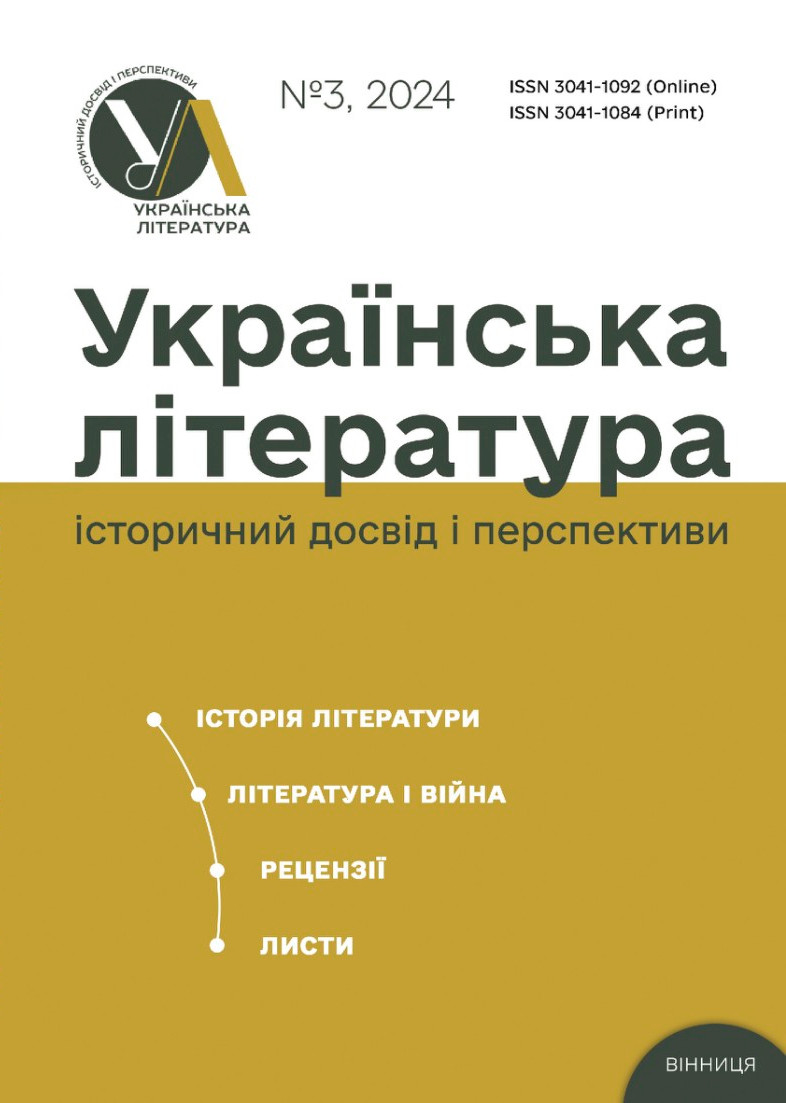To eat, (not) to love, (not) to remember, (not) to forgive: gastronomic preferences of the characters in Ivan Chendei’s short stories
https://doi.org/10.31652/3041-1084-2024-3-06Published 2024-08-24
Keywords
- short story, food, dishes, memory, ethnography.
Copyright (c) 2024 Ольга Деркачова

This work is licensed under a Creative Commons Attribution 4.0 International License.
How to Cite
Abstract
This article explores the depiction of food in Ivan Chendei’s short stories, analyzing three levels of food representation: ethnographic, everyday, and existential. The study highlights how culinary tastes and customs reveal characters’ personalities, helping to recreate their traits and memories. In Chendei’s works, food is often humble and everyday, yet it signifies more than just material status; it reflects care or indifference, love or hate.
Food serves as a narrative device that reveals the protagonists’ inner worlds, often expressing emotions that words cannot. Cooking and sharing food symbolize love and care for others. The portrayal of food in Chendei’s prose captures the national and regional atmosphere, recreating the everyday life of the Transcarpathians in the past and preserving the traditions and rituals of cooking and eating, whether in daily life or during celebrations.
For example, in «Syn (Son)», cooking demonstrates a father’s love for his son, while in «Testament», it highlights indifference toward a sick, old mother. In «Zozulka (Cuckoo)», food becomes a ritualized act, signifying the impossibility of returning to the past. In «Havrylova ‘Zolota osin’ (Havrylova’s ‘Golden Autumn’)», it symbolizes hospitality, and in «Bili hvozdyky na Novyi rik (White Carnations for the New Year)», it represents reconciliation between family members.
Chendei’s describes the process of cooking in a special way, it seems that every word has a taste and flavour. Writer’s detailed descriptions of cooking and eating bring each scene to life, with recipes that are simple yet delicious. This aligns with Chendei’s creative style, which focuses on the real and familiar since childhood rather than the imaginary. Consequently, everyday scenes in his stories become rich with symbolism, and the worlds he creates transcend mere daily existence to encompass feelings and memories.
The narrow geographical setting of the Verkhovyna in these stories also influences the characters’ food choices. Ultimately, food in Chendei’s works is a significant form of non-verbal communication, revealing characters’ habits, daily lives, traits, and their capacity for both positive and negative actions.
Downloads
References
- Бойко В. Етнічний і національний дискурс творчості Івана Чендея: дис… канд. філол. наук: 10.01.01. Київ, 2017. 202 c.
- Васьків М. «Людина є те, що вона їсть»: їжа в житті верховинця (за творчістю Івана Чендея). Науковий вісник Ужгородського університету: зб. наук. праць. Серія: Філологія; Соціальні комунікації. Вип. 28. Ужгород: Вид-во УжНУ «Говерла», 2012. С. 51‑54.
- Васьків М. Ідіостиль Івана Чендея як синтез реалізму й модернізму, епічності й ліризму. Науковий вісник Ужгородського університету: зб. наук. праць. Серія: Філологія; Соціальні комунікації. Вип. 28. Ужгород: Вид-во УжНУ «Говерла», 2012. С. 55‑57.
- Ґолька М. Суспільна пам’ять та її імпланти. Київ: Ніка-Центр, 2022. 216 с.
- Їжа і філософія: Їжте, пийте і будьте щасливі / Упор. Ф. Олгоф, Д. Монро. Київ: Темпора, 2011. 346 с.
- Россі П. Їсти. Потреба, бажання, одержимість. Львів: Видавництво Анетти Антоненко; Київ: Ніка-Центр, 2018. 152 с.
- Павличко С. Пристрасть і їжа: особиста драма Михайла Коцюбинського. https://ukrlit.net/info/theory_1/92.html
- Ставицька Л. Гендерні виміри невербальної комунікації у художньому тексті. http://dspace.nbuv.gov.ua/bitstream/handle/123456789/74065/44-Stavicka.pdf?sequence=1
- Чендей І. Вибране: В 2 т. Ужгород: Карпати, 2003. Т. 2. 518 с.
- Шивельбуш В. Смаки раю. Львів: Видавництво Анетти Антоненко; Київ: Ніка-Центр, 2016. 256 с.
- Brillat – Savar in J. The Physiology of Taste. https://businessbuildersbanquet.com/sofware/thphy.pdf
- Wilson B. Pleasures of the Literary Meal. https://www.newyorker.com/books/page-turner/pleasures-of-the-literarymeal





